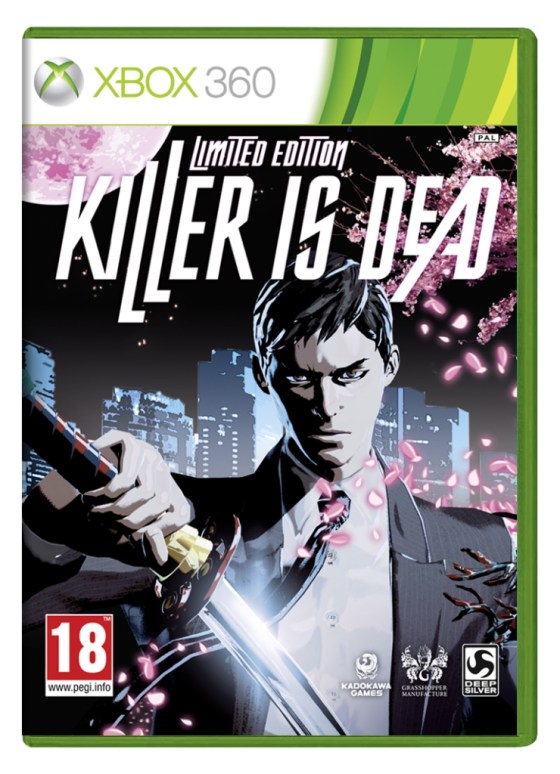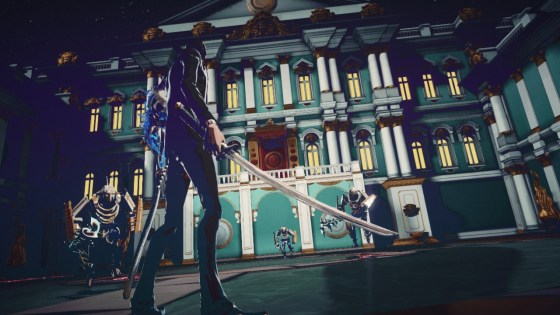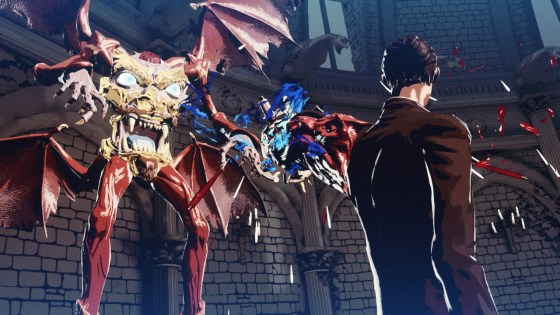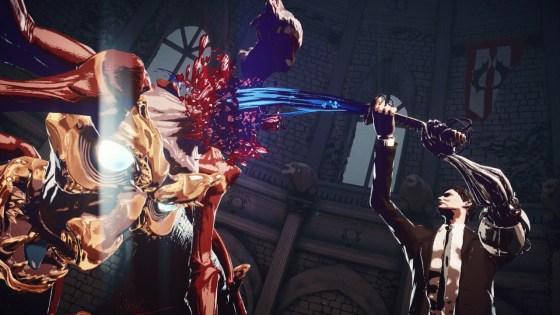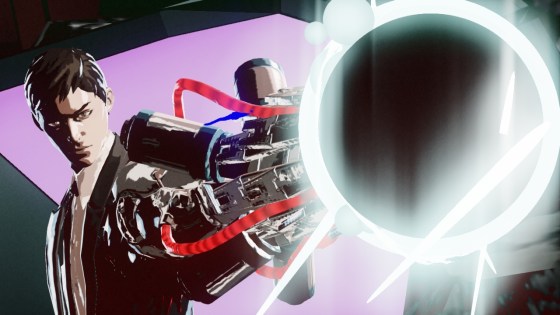Platforms: Xbox 360, PS3 and PC
Reviewed On: Xbox 360
Developer: Grasshopper Manafacture
Publisher: Deep Silver
Singleplayer: Yes
Multiplayer: No
PEGI: 18+
Me and Suda 51 have had a rocky relationship over the years. I’ve loved his work, hated it, and simply couldn’t get into some of it. Lollipop Chainsaw, the last game from the mind of Suda 51, fell firmly into the last category, a game that was, I felt, an okay hack ‘n’ slasher, but not something I could personally get in to for a variety of reasons. Now the madman himself is back with a new game that is, in some ways, like a spiritual successor to both Killer7 and No More Heroes. It’s flashy and crazy, but is it actually good?
You take on the role of Mondo Zappa, a so-called Executioner that wields a sword and a robotic left arm called the Musselback, which is capable of transforming itself into one of four different unlockable sub-weapons, as well as performing some other neat tricks like replicating a human finger so that you can pass through doors locked with a fingerprint scanner. Dressed impeccably in a sharp black suit and sporting slick hair, Mondo has an aura of a wannabe James Bond about him, especially when it comes to his love of women. Unlike the legendary spy, though, Mondo is lacking the suave nature and easy charm that made Bond such an icon. Mondo works for the Bryan Execution Firm, run by…well, Bryan. Mondo takes on various contracts through the firm to execute people, monsters or whatever else the client wishes, all for substantial sums of money, as one would expect. The Bryan Execution Firm’s existence within the world is never entirely explained, leaving it with a certain air of mystery. It seems that they’re approved by the government, or at least the government puts up with their continued existence, but then pretty much anybody is able to turn up, complain a bit and get someone killed for a considerable fee. And that’s something you’ve got to accept when it comes to Suda 51 games: very few things are ever explained or given a reason, they’re just there and they just happen because…just because, really. Sometimes this leads to interesting mysteries, like that of the Bryan Execution Firm, where your mind attempts to fill in the blanks, and other times it can just be annoying, especially when it comes to the more absurd things presented to you.
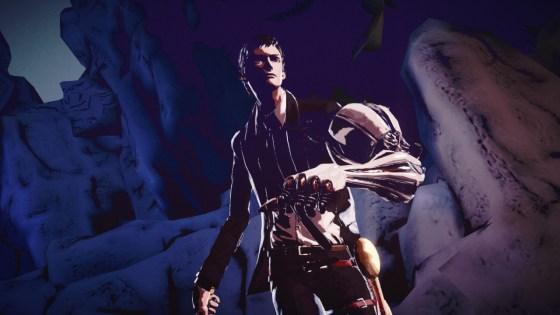
While talking about the game Suda 51 has often mentioned it as being a very personal tale and a reflection of the darker side of the James Bond lifestyle, but there’s not much evidence of that. Mondo himself is a fairly flat character, displaying a fairly calm attitude and just likable enough to keep the story rolling along but nothing more. There’s an occasional effort to flesh out his backstory and make him more relatable, but it falls mostly flat because it simply has no emotional range to it. Personally, I liked Mondo in that he was a sword-wielding badass in a suit, but as an actual person I found it nigh on impossible to give a damn about him, or for anyone around him. Still, I do give credit to the man voicing Mondo as he actually does a rather good job of it. Mondo’s supporting cast of characters are also a pretty bland lot, exhibiting very little signs of genuine personality beneath the surface. Big boss Bryan Roses has had a fair chunk of his body replaced by robotic parts and it would have been great to find out the story behind that, but we never get to. Monda has a hyperactive girl who follows him around and who speaks in a high-pitched squeal for most of the time which is sure to grate on the nerves of many people, but she never manages to become anything more than an irritation, and somehow fails to feel like an integral part of the storyline, despite the role she serves within it. Meanwhile Vivienne, who helps Bryan run the company, seems to have the very important job of complaining about the firm not getting paid for the latest contract and keeping her jacket open just enough so that each scene fulfills its cleavage qouta.
The game is utterly manic, prancing from concept to concept with little thought ever given to actually stitching any of it together in a meaningful way or to even fleshing anything out. It’s like Suda 51 and Grasshopper thought up a load of mad scenarios that are certainly cool to look at and play through, but had no way of weaving them all together properly to create something coherent. The quality of the writing is equally manic, ranging from being okay in a sort of strange, offbeat way to being cringe worthy, the characters delivering clumsy dialogue. At one point Mondo casually breaks the fourth wall for no reason, referring to the fact that he’s in a videogame while chatting to a bad guy. His breaking of the fourth wall was utterly pointless, not serving the plot in any way nor even being used for humour. It just happens. After that it’s mentioned a few more in the entire game, again for absolutely no reason. Nothing funny comes of it, nor is it used to perhaps shine a light on the nature of game’s or humanity. Why? What was the point of this? It broke the flow of the story, and for what?
Still, the manic nature of the game does mean you’ll find yourself involved in some pretty cool stuff, from taking down run-away trains that have been granted life (there’s some really painful dialogue about steam engines being a man’s passion in there) to finding yourself in a duel with a man who can summon a tiger from the tattoo on his back. You’ll accept contracts from people who have lived on the moon, and others who are actually dead. The beginning of the game alone is barmy, tasking you with battling through a bug-infested house brimming with color and which constantly defies physics before facing off against a horrifying spider/alien/woman thing. The quality of the writing, pacing and plot may be all over the place, but there’s no denying that Suda 51 still has a sharp imagination and that he has an eye for cool visual moments. There’s a cheesy, action vibe running throughout the game that clicks well with me.
There’s a very loose plot thread connecting all of the various missions that Mondo embarks on, with the occasional snippet providing brief hints at the overall narrative throughout, but it doesn’t actually come together until the very end and doesn’t make a whole lot of sense when it does, and will likely leave you wondering why any of it happened. On the other hand the episodic structure of the game does mean that you can play a section and come back weeks later without having to worry about catching up on the plot by reading Wikipedia, not that Wikipedia can always be trusted.
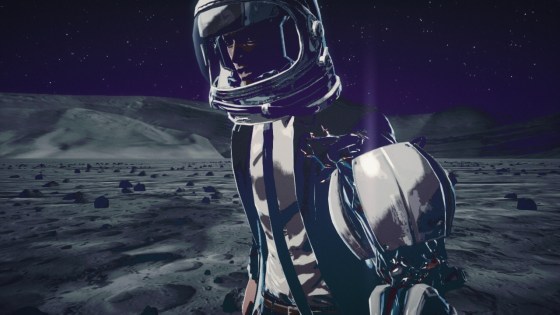
Strangely there are a few moments where the game does attempt to become quite poignant, but fails to pull it off. One section just after a boss battle is actually quite well done. But most of the aims that Suda 51 claimed while working on the game fall flat on their face. Boss battles always end with you holding the right-trigger to raise your sword, and releasing it to deliver the finishing blow. Suda 51 claims this is so the player feels the emotional weight of ending a life, of swinging that sword, which is a concept I approve of, but it’s hard to feel that emotion when you’ve literally spend the previous 15-minutes in a whirl of death and violence. The bosses themselves, bar two cases, I felt, don’t exactly illicit any sympathy, either, making it all the easier to swing the sword. There’s several messages strewn throughout the game and they’re worth delivering, but they’re so heavy-handed that I honestly found them funny rather than thoughtful.
The key to enjoying Killer is Dead is to simply switch off and enjoy the spectacle, taking each of the 12 episodes as they come rather than worrying too much about the complete narrative. Do this and you’ll become happily lost in a haze of madness, one that would be much improved with the inclusion of copious amounts of alcohol.
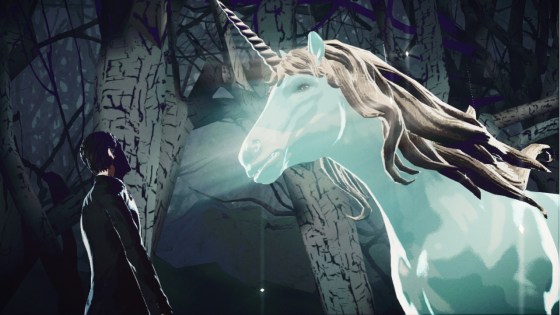
At its core Killer is Dead is very much an action game in which you’ll slice your way through hordes of foes. A tap of the X button causes Mondo to lash out with his blade, while tapping Y uses the Musselback arm to perform a defensive break so that you can destroy an enemy’s guard and continue your brutal assault. The B button performs dual functions: block and dodge. At first combat is slick, but seems simplistic. As the game progresses, however, I was pleasantly surprised to discovered a satisfying degree of depth just waiting to be uncovered. Firstly, if you correctly time a dodge or execute a parry you’ll be rewarded with the ability to unleash a devastating button-mashing counter-assault. As you land more and more strikes without being hit yourself you’ll find the speed and power of your attacks increases, until eventually you’ll become a whirling blur of death that would make Rambo take a step back in astonishment. The downside is that as your own speed increases your sword forms blue arcs in the air, making it a bit harder to judge enemy attacks and either block them or dodge them. Combat becomes about keeping the flow going, moving from enemy to enemy in fluid dance of death.
Manage to defeat a certain enemy type without them ever landing a single blow on your wonderfully tailored suit and you’ll be rewarded with a drop to slow-motion and a choice of one of four possible executions that reward you with things such as health or blood. Ripping through a crowd of enemies and being given the choice to execute each of them in this manner is a beautiful thing, because managing to do so comes with the knowledge that you were never hit, that you were perfect in your offense and defense. Satisfying is almost an understatement.
Blood has a couple of different uses and other than earning it via executions your primary means of filling the gauge is to simply go on the offensive, which is yet another encouragement for players to always attack rather than sit back and defend. With a purchased upgrade Blood can be used to regain health, and it also powers Mondo’s sub-weapons. The best use of Blood, though, is unleashing adreneline attacks which let you slice certain enemies in half with a single slash, consuming a set amount of the red liquid in the process.
The sub-weapons are interesting, coming in the form of a simple blaster, an ice gun, a drill and a powerful cannon, but they’re too awkward to fit into a fight smoothly. Bringing up a sub-weapon requires you to hold down the left trigger and then press or even hold the right trigger to use the weapon, but doing so is clumsy and a little slow, so incorporating them into fights feels awkward. This becomes most apparent when you’re dealing with the ranged enemies so that the game insists on sometimes throwing into the fight, forcing you to bring a halt to the flowing swordplay in order clumsily draw your blaster and attempt to dispatch them from afar with some headshots.

Speaking of enemies who wield ranged weaponry, they are only one of three flaws I can pick out from amongst the combat system. Because of the aforementioned clumsiness of the sub-weapons dealing with, and dodging their attacks, in a fight can be a pain, though thankfully one that doesn’t arise too often. The second irritation comes in the form of attacks that can stun you, something which the majority of fighting games abandoned a long time ago as being left reeling during a battle as you frantically waggle the stick to regain control can be frustrating for the player, especially if it happens to be from a ranged attack like it often is in Killer is Dead. The final flaw is smaller: the dodge and block mechanics can, on occasion, feel a little slow to react. It’s not bad enough to spoil the combat in any real way, but it is there and can sometimes cause you to get hit.
As more enemy types get introduced and you begin to master the combat system battles become more and more entertaining. It doesn’t have the same level of responsiveness or depth that something like Bayonetta offers, but it sits well within the structure of the game. The argument has often been made in the past that Suda 51 games are all flash with little substance, something that I felt rang true with Lollipop Chainsaw, but this time round he and Grasshopper have proven that they can produce the substance to match style, at least in terms of the combat. Killer is Dead is glorious carnage.
The visual style presented here is undeniably unique and striking, and is therefore, I predict, going to be extremely divisive amongst gamers. Which way the split is going to go is something that I’m not even going to try to predict, but the one thing I will say is I think that people will either love it or hate it – I see no middle ground on this one. I’m also not going to attempt to describe the aesthetics of the game in any great detail, because quite honestly I’m unsure of how to put it into words, of how to translate the game’s incredibly strong contrast level and vivid flashes of color into text. It is beyond my limited skill to do so. But then, that’s why we weigh down these reviews with pictures, I suppose, so that when words fail pictures can smack you in the face and make you pay attention.
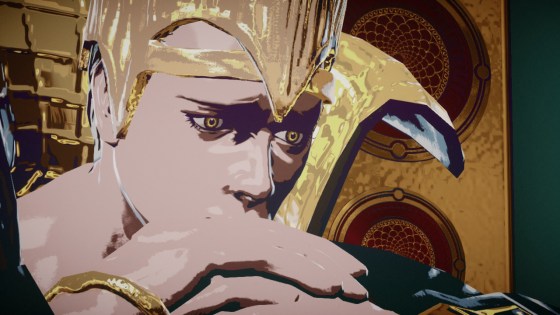
Personally I was enthralled by the visual style of Killer is Dead. The game is, as mentioned, utterly insane and the tone of the visuals matched this nicely, creating what should have been a cohesive whole if it was not for the game’s slightly manic tendencies with regards to its storytelling and way that scenes play out. But I will say that as impressive as the game’s graphics are from a purely artistic stance, a lot of the environments are pretty lacking in detail, feeling sparse and lifeless, and sometimes even bland. There are some lovely levels, but later in the game there’s also a couple of mundane sections that make use of boring metal corridors and the like.
Outside of the main storyline you can choose to focus on Mondo’s other interest, women, in the game’s Gigolo mode, which has gotten a fair amount of controversy since being announced and shown off. The goal of the mode is to successfully seduce a woman using presents purchased in the gift store to woo them. Before you can hand over your present, though, you must first, for reasons I can’t fathom, build up a meter, which is done by staring at the woman’s breasts and between her thighs whenever she’s not looking. If she catches you staring then the mood meter on the right side of the screen decreases, and you must regain it by quickly looking away.
This mode compels me to touch upon a subject that I have, until now, never actually talked about within a review, because such things are usually out of place within the context of a videogame review. I also tend to avoid talking about it because I often tend to find the entire situation rather stupid at times, and also incredibly hypocritical – nobody bats an eyelid about the over-grown, massive men that usually inhabit videogames, men who most of us have little chance of ever matching in terms of physique. They’re the men of a perfect world. Heavens fucking forbid if a woman is overly sexualized or exaggerated, though, because apparently it’s alright for men to be portrayed in that light, but not women. I’ve also found that most of the time woman being sexualized doesn’t impact the game much, or makes sense within the universe that the developers have created, and it’s therefore not really worth chatting about it.
Anyway, I’m veering off course, here. The reason I bring it up in this review is that for the first time I really did feel that this game pushes the boundaries. The entire goal of the mode is to simply stare at women, and I quickly started to feel a little uncomfortable about doing so, not in a physical sense but mentally, wondering why the hell I was even doing it. As a man I’m not going to sit here and attempt to claim that I’ve never glanced at a woman and enjoyed admiring her – I’m only human after all. But there’s a difference between doing that and simply staring for such prolonged periods of time. This honestly feels like a very cheap attempt at using sex to sell a game, and a very poor one at that.
Yet this is not an opinion I’m going to let color this review or effect my score of the game, instead I’m going to drop back into a more objective mode, because the biggest problem with Gigolo mode is that it’s just really bloody boring from a gameplay perspective. Though it does offer a brief quiet respite from the manic storyline and quick combat, it offers no compelling gameplay nor anything else of note. You just gawk at ladies with the analogue stick and attempt to make sure they don’t catch you doing so. It’s not even challenging. At first figuring out which present will impress a lady the most is pure guesswork, but once you’ve figured it out you can keep using the same present over and over again, with the only penalty being that the price of the present increases every time it is purchased. You’re allowed to go on as many dates as you wish with each woman, but they never change.
The Gigolo sections add absolutely nothing to Killer is Dead, and actively damages the overall quality of the game, rather than increasing it as they should. These missions would have arguably had some justification had they at least been used to flesh out Mondo’s personality a little more, attempting to cultivate that James Bond theme, but he remains almost entirely mute throughout each date, and your targeted “beauty” utters the same lines few lines of dialogue over and over. Still, since completing this missions is the only way to gain all four of the sub-weapons on the game, you’ll feel compelled to complete them for the rewards. After you’ve unlocked the all of the sub-weapons you can also continue to play the missions in order to be presented with some free stuff.
In fact any time you venture outside of Killer is Dead’s storyline and joyful combat mechanics into the various sub-missions on offer the level of quality becomes akin to a pick ‘n’ mix. Examples of more frustrating missions include bland turret sections where you just hold down the trigger until everything is dead. Attempting to hunt down bugs within a time limit is another rather dull task, and another mission riding around on a motorbike attempting to run over enemies is downright annoying thanks to clumsy and unresponsive controls. They flesh out the game’s content to a degree (I completed the storyline and the vast majority of the missions in 8-hours), but do very little more than that. Only a few of the sub-missions, usually involving the combat mechanics, offer something really worthwhile and fun. In particular combat challenges offered up by a certain character, which are unlocked by finding her during main missions, let you hone your skills in satisfying ways. The rewards for completing these missions is unlocking some more items in the gift shop and even more cash, which in turn can be spent on presents for when you’re attempting to impress women, which, I felt, results in a rather unsatisfying reward loop.
However, money can be used to purchase crystals with which to purchase upgrades from the limited selection on offer. RPG-esque levelling up systems have become mainstream these days, invading practically every genre around. Killer is Dead lets you upgrade Mondo with a couple of news moves for combat, increase the effectiveness of sub-weapons and unlock a couple of other handy things, such as trading Blood for Health and removing some limitations on your sword, making it more deadly. There’s no a lot of choice to be found, so if you were hoping you could taylor Mondo to a certain playstyle or something then you’ll be disappointed, but the system is still welcome and brings a sense of progression to the game. This progression tree, as limited as it may be, is also the primary reason for bothering to run through the various side-missions as you can gain crystals to be spent on powering up Mondo.
Throughout the entire game your performance is analysed and you’ll be rewarded with more cash and a higher grade the better you do, with each mission being uploaded to a global leaderboard so that you can claim bragging rights. The nature of the combat makes it rather rewarding to head back into missions and attempt to improve your performance, giving the game some replay value.
KIller is Dead can feel like a rather inconsistent experience from start to finish, but at its core is a set of strong combat mechanics that manage to override any other problems. Perhaps this is simply another case of a Suda 51 title not clicking with me, but I found the story to be a mess, the characters flat and the writing generally lackluster. Still, it’s hard not to imagine Suda 51 fans flocking to purchase this game, and rightfully so as they’ll likely really enjoy this. For everyone this is a fine action game so long as you can handle the weirdness.
The Good:
+ Strong combat.
+ A unique aesthetic.
+ Bonkers.
The Bad:
– Bonkers.
– The storyline.
– Inconsistent quality.
The Verdict: 3/5 – Good
Suda 51 and Grasshopper have again delivered a good title, this one mostly carried by the strength of its combat. Fans of Suda 51 will love it, and those who aren’t won’t have their minds changed by it.

